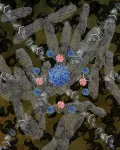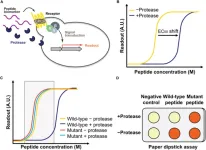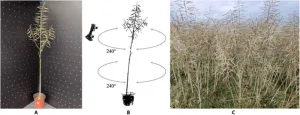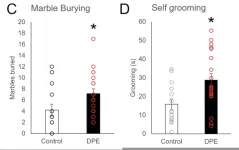(Press-News.org) Cardiff University media release/Datganiad i’r wasg gan Brifysgol Caerdydd
Under embargo until 16:00 BST/11:00 EST on Tuesday 25 April 2023/O dan embargo tan 16:00 BST/11:00 EST ddydd Mawrth 25 Ebrill 2023
Using artificial intelligence to create a tsunami early warning system
Real-time classification of underwater earthquakes enables earlier and more reliable tsunami alerts
An early warning system that quickly classifies submarine earthquakes and determines the risk of tsunami events has been developed by scientists at Cardiff University.
The team, from the University’s School of Mathematics, combined state-of-the-art acoustic technology with artificial intelligence (AI) to monitor tectonic activity in real-time.
Their work, published today in Physics of Fluids, used sound recordings captured by underwater microphones, called hydrophones, to measure the acoustic radiation produced by 200 earthquakes that happened in the Pacific and Indian Ocean.
Dr Usama Kadri, a Senior Lecturer in Applied Mathematics at Cardiff University and the study’s co-author, said: "Tsunamis can be highly destructive events causing huge loss of life and devastating coastal areas, resulting in significant social and economic impacts as whole infrastructures are wiped out.
"Our study demonstrates how to obtain fast and reliable information about the size and scale of tsunamis by monitoring acoustic-gravity waves, which travel through the water much faster than tsunami waves enabling more time for evacuation of locations before landfall."
Acoustic-gravity waves are naturally occurring sound waves that move through the deep ocean at the speed of sound and can travel thousands of kilometres in the water.
Dr Kadri added: "This acoustic radiation also carries information about the originating source of the tectonic event and its pressure field can be recorded at distant locations, even thousands of kilometres away from the source.
"This is important because not all underwater earthquakes cause tsunamis."
Current warning systems rely on waves reaching sea buoys before tsunami warnings are triggered, leaving little time for evacuation.
Sea buoys are used together with seismic sensors to measure the underwater earthquake, but the technology is not always accurate in predicting the danger posed by resulting tsunamis.
Designed to be used alongside existing warning systems, the team use a computational model to triangulate the source of the tectonic event using hydrophone recordings.
Algorithms then classify the earthquake’s slip type and magnitude before earthquake properties like length and width, uplift speed, and duration are calculated to reveal the size of the tsunami.
Co-author Dr Bernabe Gomez Perez, who undertook the research while at Cardiff and is now at the University of California in Los Angeles, said: "Tectonic events with a strong vertical slip element are more likely to raise or lower the water column compared to horizontal slip elements.
"So, knowing the slip type at the early stages of the assessment can reduce false alarms and complement and enhance the reliability of the warning systems through independent cross-validation."
The team’s work predicting tsunami risk is part of a long-running project to enhance natural hazard warning systems across the globe.
Their latest development features in user-friendly software which is set to be hosted in national warning centres later this year.
ENDS
Notes to editors
Interviews
Dr Usama Kadri is available for interviews.
Paper
The article, "Numerical validation of an effective slender fault source solution for past tsunami scenarios," will appear in Physics of Fluids on Tuesday 25 April 2023 at 16:00 BST/11:00 EST and can be accessed at: https://doi.org/10.1063/5.0144360.
For more information contact:
Jonathan Rees
Communications and Marketing
Cardiff University
ReesJ37@cardiff.ac.uk
Cardiff University is recognised in independent government assessments as one of Britain’s leading teaching and research universities and is a member of the Russell Group of the UK’s most research intensive universities. The 2021 Research Excellence Framework found 90% of the University’s research to be word-leading or internationally excellent. Among its academic staff are two Nobel Laureates, including the winner of the 2007 Nobel Prize for Medicine, Professor Sir Martin Evans. Founded by Royal Charter in 1883, today the University combines impressive modern facilities and a dynamic approach to teaching and research. The University’s breadth of expertise encompasses: the College of Arts, Humanities and Social Sciences; the College of Biomedical and Life Sciences; and the College of Physical Sciences and Engineering. Its University institutes bring together academics from a range of disciplines to tackle some of the challenges facing society, the economy, and the environment. More at www.cardiff.ac.uk
Physics of Fluids is devoted to the publication of original theoretical, computational, and experimental contributions to the dynamics of gases, liquids, and complex fluids. More at https://aip.scitation.org/journal/phf
END
Using artificial intelligence to create a tsunami early warning system
Real-time classification of underwater earthquakes enables earlier and more reliable tsunami alerts
2023-04-25
ELSE PRESS RELEASES FROM THIS DATE:
Researchers at Albert Einstein College of Medicine discover how long-lasting memories form in the brain
2023-04-25
April 25, 2023—(BRONX NY)—Helping your mother make pancakes when you were three…riding your bike without training wheels…your first romantic kiss: How do we retain vivid memories of long-ago events? As described in a paper published online on April 25 in Neuron, researchers at Albert Einstein College of Medicine have found the explanation.
“The ability to learn new information and store it for long periods is one of the brain’s most remarkable features,” said Robert H. Singer, Ph.D., ...
Researchers find rhythmic brain activity helps to maintain temporary memories
2023-04-25
New research shows that rhythmic brain activity is key to temporarily maintaining important information in memory. Researchers at the Del Monte Institute for Neuroscience at the University of Rochester published these findings today in Current Biology that found brain rhythms—or patterns of neuronal activity—organize the bursts of activity in the brain that maintain short-term connections.
“The thought has been that the temporary storage of important information is linked to neurons in the brain that just fire away, retaining that information until it is no longer needed. Recent research has shown that it might not be such persistent ...
Near-universal T cell immunity towards a broad range of bacteria
2023-04-25
Typically T cells of the immune system respond to a specific feature (antigen) of a microbe, thereby generating protective immunity. As reported in the journal Immunity, an international team of scientists have discovered an exception to this rule. Namely, a group of divergent bacterial pathogens, including pneumococci, all share a small highly conserved protein sequence, which is both presented and recognized by human T cells in a conserved population-wide manner.
The study set out to understand immune mechanisms that protect against pneumococcus, a bacterial pathobiont that can reside harmlessly in the upper respiratory mucosae but can also cause infectious ...
Novel living yeast-based dual biosensor for detecting peptide variants
2023-04-25
Biosensors—sensors that can detect biological samples—are powerful tools for understanding the function, composition, and structure of biochemical molecules. Biosensors are often applied for the detection of proteins and their subunits, called peptides, yielding a wide range of biomedical applications. In 2017, researchers from Columbia University in USA engineered a living yeast biosensor by rewiring pheromone-related signaling pathways used by yeast for mating. In the presence of the pheromone peptide, the G-protein coupled receptor (GPCR) could detect the peptide, triggering a cascade that would eventually activate a ...
Sizing them up! An algorithm to accurately quantify rapeseed silique morphology
2023-04-25
Rapeseed or oilseed rape (Brassica napus L.) is an important crop cultivated worldwide for its oil-rich seeds. The rapeseed silique is an organ that plays a role in photosynthesis, sends developmental signals to maturing seeds, and provides a capsule that harbors the seeds. High-yield rapeseed varieties have both a high number and optimal morphology–the form and structure–of siliques. In this regard, rapeseed genotype and cultivation method directly influence the number of siliques that a plant produces. Thus, accurately quantifying silique development parameters is critical for predicting ...
Columbia University launches Center for Precision Psychiatry & Mental Health with $75 million grant from the Stavros Niarchos Foundation
2023-04-25
NEW YORK, April 24, 2023—Columbia University today announced the establishment of the Stavros Niarchos Foundation (SNF) Center for Precision Psychiatry & Mental Health at Columbia University. The center will catalyze the scientific innovation and clinical implementation of precision medicine to advance the prevention, diagnosis, and treatment of mental illness. The center is being established with a $75 million grant from the Stavros Niarchos Foundation (SNF), an international philanthropic organization, as part of SNF’s Global Health Initiative (GHI).
The SNF Center is a joint effort of the Department of Psychiatry at Columbia University Vagelos College of Physicians ...
Research links common insecticide to neurodevelopmental disorders
2023-04-25
A new study from The University of Toledo suggests early exposure to a common class of insecticides called pyrethroids may increase the risk of autism and other developmental disorders, even at levels currently recognized as safe by federal regulators.
The findings, which come from a study of mice, were published today in the peer-reviewed journal PNAS Nexus.
Pyrethroids are some of the most widely used insecticides in the country, appearing in both consumer products and industrial preparations.
“If ...
New research sheds light on how to choose quality eHealth tools
2023-04-25
With so many eHealth tools available, it can be challenging to select the best one for a specific health need. A recent study published in JMIR Human Factors provides valuable insights on how to choose quality eHealth tools in an evolving landscape of digital health technology. This study titled “Assessing the Quality and Impact of eHealth Tools: Systematic Literature Review and Narrative Synthesis” comprehensively examined how the quality and impact of eHealth tools are currently assessed.
Led by Dr Christine Jacob, a health tech researcher at the University of Applied Sciences and Arts Northwestern ...
SwRI tests automated vehicles in virtual off-road environments
2023-04-25
SAN ANTONIO – April 25, 2023 – Southwest Research Institute (SwRI) has created a 3D simulation tool to test automated vehicles in virtual off-road environments modeled after real-world conditions. The research expands SwRI’s investment into software-in-the-loop solutions to test connected and automated vehicles (CAVs) in scenarios ranging from congested roadways to off-road terrain. A simulated environment, or a 3D “software loop,” supports evaluations of an infinite number of scenarios that would be cost-prohibitive to test in the real world.
The technology meets U.S. Department of Defense demands ...
Pesticides and neurodevelopment disorders
2023-04-25
A study of 72 mice mothers and their litters suggests a popular pesticide may cause neurodevelopmental disorders in humans. Previous studies have shown that nearly half of the risk for neurodevelopment disorders, including autism, is environmental, but few specific environmental causes have been clearly identified. James Burkett and colleagues exposed mice to low doses of pyrethroid pesticide deltamethrin during pregnancy and lactation. Pups of exposed mothers vocalized less compared to pups of unexposed mothers. ...
LAST 30 PRESS RELEASES:
New expert guidance urges caution before surgery for patients with treatment-resistant constipation
Solar hydrogen can now be produced efficiently without the scarce metal platinum
Sleeping in on weekends may help boost teens’ mental health
Study: Teens use cellphones for an hour a day at school
After more than two years of war, Palestinian children are hungry, denied education and “like the living dead”
The untold story of life with Prader-Willi syndrome - according to the siblings who live it
How the parasite that ‘gave up sex’ found more hosts – and why its victory won’t last
When is it time to jump? The boiling frog problem of AI use in physics education
Twitter data reveals partisan divide in understanding why pollen season's getting worse
AI is quick but risky for updating old software
Revolutionizing biosecurity: new multi-omics framework to transform invasive species management
From ancient herb to modern medicine: new review unveils the multi-targeted healing potential of Borago officinalis
Building a global scientific community: Biological Diversity Journal announces dual recruitment of Editorial Board and Youth Editorial Board members
Microbes that break down antibiotics help protect ecosystems under drug pollution
Smart biochar that remembers pollutants offers a new way to clean water and recycle biomass
Rice genes matter more than domestication in shaping plant microbiomes
Ticking time bomb: Some farmers report as many as 70 tick encounters over a 6-month period
Turning garden and crop waste into plastics
Scientists discover ‘platypus galaxies’ in the early universe
Seeing thyroid cancer in a new light: when AI meets label-free imaging in the operating room
Neutrophil-to-lymphocyte ratio may aid risk stratification in depressive disorder
2026 Seismological Society of America Annual Meeting
AI-powered ECG analysis offers promising path for early detection of chronic obstructive pulmonary disease, says Mount Sinai researchers
GIMM uncovers flaws in lab-grown heart cells and paves the way for improved treatments
Cracking the evolutionary code of sleep
Medications could help the aging brain cope with surgery, memory impairment
Back pain linked to worse sleep years later in men over 65, according to study
CDC urges ‘shared decision-making’ on some childhood vaccines; many unclear about what that means
New research finds that an ‘equal treatment’ approach to economic opportunity advertising can backfire
Researchers create shape-shifting, self-navigating microparticles
[Press-News.org] Using artificial intelligence to create a tsunami early warning systemReal-time classification of underwater earthquakes enables earlier and more reliable tsunami alerts







